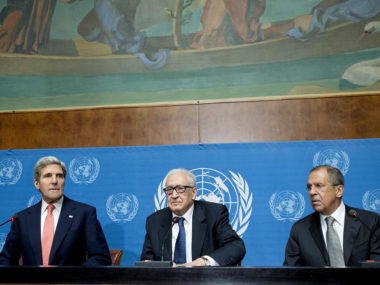
The collapse of the cease-fire in the Israeli-Gaza conflict, less than 2 hours into what was hoped to be a 72 hour respite, is tragic, but entirely unsurprising. Cease-fires are inherently unstable – they require cooperation and some modicum of trust between parties who are, by definition, intent on killing each other. So perhaps it is more surprising that they ever last than that they fail.
But some of them do last, and there is enough variation among them for us to be able to say why this one likely fell apart, and more importantly, what could be done to design a cease-fire that would be more likely to stick.
This cease-fire, like many others faltered among the types of “the other guy started it” recriminations that are familiar to any parent faced with a playground squabble. Hamas claims that it was responding to Israeli forces advancing into Eastern Rafah. Israel claims that its soldiers were moving to destroy a tunnel and were attacked, unprovoked, by Palestinian fighters. Both sides present, and mostly likely honestly perceive, what they were doing as entirely defensive and legitimate. Both sides are equally sure that what the other did was offensive and illegitimate. It is a classic security dilemma. From the Israeli perspective, the tunnels are a threat and their continued destruction was allowed under the terms of the cease-fire. From the Palestinian perspective, the advancement of Israel soldiers into Rafah was a provocation and a violation of the cease-fire’s specification that “during this time [of the cease-fire] the forces on the ground will remain in place.” The finger-pointing and recriminations now are about as inevitable as the clash itself.
Why do some cease-fires last longer than others?
Some cease-fires last because one side is defeated. But there is little likelihood of a clear military victory for either side in this conflict. Hamas has no hope of militarily defeating the massively stronger Israeli Defense Forces, while Israel’s use of force serves only to strengthen Hamas politically.
But my research on both interstate (e.g. article and book) and civil wars (article and book) point to some of the ways that cease-fires can be made more durable, even when neither side is defeated outright:
Specificity – cease-fires that are more specific about what is and what is not allowed under their terms last longer than vaguer agreements. As far as I can tell, the only specification of terms in this cease-fire is the above quoted statement that forces would “remain in place.” Israel clearly interpreted this to mean that forces could remain in Gaza and could continue to maneuver to locate and destroy tunnels. Presumably Hamas interpreted it to mean IDF soldiers would not move further into areas of Gaza. This ambiguity seems to be at the heart of what undid the cease-fire.
Formality – evidence from interstate wars suggests that formal agreements are more likely to last than tacit or informal agreements. The act of signing a formal piece of paper (as opposed to agreeing more tacitly or less publicly to a cease-fire proposal, as was the case here) invokes domestic and international audience costs in ways that make peace more stable, at least at the margins.
Separation of forces – clashes like the one that upended this cease-fire are almost inevitable if soldiers from opposing sides run into each other. Any long term cease-fire has to have some way to keep this from happening.
Peacekeeping – whether this entails simply monitors or more involved peacekeeping missions, my research shows clear evidence that deploying international personnel (it does not necessarily have to be the UN) to help belligerents maintain peace dramatically reduces the chance that fighting will resume.

Dispute resolution – accidental or unintended incidents or clashes can easily spark renewed warfare. Having some mechanism (whether it be through peacekeepers or some other institution) for both sides to lodge complaints and discuss problems can keep things from spiraling out of control. One way that this can help is by providing a third option besides responding with force (and escalating the problem) or doing nothing (and risking looking weak).
A cease-fire that entailed some or all of these measures would have been much more likely to stick than the one that has just collapsed in Gaza. None of these ways of designing a better cease-fire are easy to come by, of course. It’s hard to imagine Hamas and Israel agreeing formally and specifically on whether IDF can continue to destroy tunnels, or to allow international peacekeepers into Gaza to monitor the cease-fire. And, to be fair, such measures are not common in short, temporary, humanitarian cease-fires such as this one.
But the collapse of this cease-fire will arguably make the conflict worse than it was before, increasing both sides distrust and creating disillusionment with the very idea of trying to reach a cease-fire, much less a long-term solution to the Israeli-Palestinian problem. Short humanitarian cease-fires can bring much needed relief to those suffering the scourge of war. But, in hindsight at least, 2 hours of relief does not seem worth the damage that the failure of this cease-fire has likely done. And while this one was probably not deliberately designed to fail, it was certainly not designed to succeed. If there is to be any hope of a successful cease-fire in this conflict, the next attempt must incorporate some of what we know about how to make peace last.






8 comments
The “tank” in the above picture seems to have mislaid its gun.
It’s tempting to try to understand why cease fires hold or break using a rational game-theoretic analysis. It looks like they fail invariably when at least one side has sufficient hatred of the other to be unwilling to agree to anything short of annihilation of the enemy. Under such circumstances, a cease fire is an opportunity to inflict harm on the despised other — damn the consequences. To cooperate with the enemy ever is a sign of weakness.
I think that’s unfair both of the analysis in the article and the approach in question. Preferences are set by things such as hatred, ambition, and other “irrational” factors but choices are still made in the end. Even if Hamas/Israel wants to see each other wiped out ideally, they can and most likely will settle for the next best thing if the benefits or costs are worth it.
I think you hit the nail on the head in noting the ambiguity of the agreement, particularly regarding tunnels. Eliminating the tunnels has been Israel’s principal military objective, and the Israeli understanding of a cease-fire has consistently included its right to pure that objective without being shot at. It’s not that difficult to understand why Hamas would reject that, apart from the fact that its own objectives never get included. Having these thinks negotiated by proxies because the principals won’t talk to each other probably doesn’t help clear up the ambiguities either.
In this case, the official joint statement issued by the US and the UN states, as you say, only that there will be an “unconditional humanitarian cease-fire” and that forces shall “remain in place.” It says nothing about tunnels. Kerry and two unnamed senior State Department officials at a press briefing, however, repeatedly argued that this meant Israel could continue to destroy tunnels as long as those tunnels were on its side of the line, once it had established where that line was. Israeli spokesmen that I’ve heard stressed their right to continue to destroy the tunnels, but I don’t recall them saying anything about remaining within any lines. (The reports I’ve seen haven’t mentioned whether the incident Friday morning was inside or outside any line.) Hamas spokesmen, speaking after the fact, have said that they only promised to stop firing rockets, not to stand by and watch while the Israelis destroyed their tunnels. To determine who broke the agreement, it would be extremely helpful to know what the agreement was.